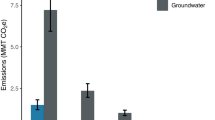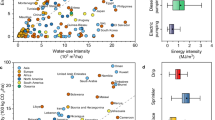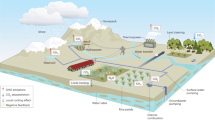Abstract
Irrigation effectively increases yields and buffers against intensifying climatic stressors to crop productivity but also produces greenhouse gas (GHG) emissions through several pathways including energy use for pumping (on farm and for interbasin water transfers), N2O emissions from increased denitrification under elevated soil moisture, and degassing of groundwater supersaturated in CO2. Despite irrigation’s climate adaptation potential, associated GHG emissions remain unquantified. Here we conduct a comprehensive, county-level assessment of US GHG emissions from these irrigation-related pathways, estimating that irrigation produces 18.9 MtCO2e annually (95% confidence interval 15.2–23.5 Mt), with 12.6 Mt from on-farm pumping, 1.1 Mt from pumping for interbasin transfers, 2.9 Mt from elevated N2O and 2.4 Mt from groundwater degassing. These emissions are highly spatially concentrated, revealing opportunities for geographically targeted and source-specific GHG mitigation actions. These findings enable strategic consideration of GHG emissions in decision-making associated with irrigation expansion for climate adaptation.
This is a preview of subscription content, access via your institution
Access options
Subscribe to this journal
Receive 12 digital issues and online access to articles
118,99 € per year
only 9,92 € per issue
Buy this article
- Purchase on SpringerLink
- Instant access to full article PDF
Prices may be subject to local taxes which are calculated during checkout



Similar content being viewed by others
Data availability
County-level emissions estimates and associated CIs, broken down by emissions source and water source, are available as Supplementary Table 2. The data required to reproduce the figures and analyses presented in this manuscript are available on Zenodo at https://doi.org/10.5281/zenodo.12552398 (ref. 37). The raw data used to calculate emissions estimates for groundwater degassing are available in the same repository. The raw data used to calculate emissions from individual interbasin transfer operators are available upon request to the corresponding author. The raw National Resources Inventory data underlying the N2O emissions model are confidential, and data access is regulated by the USDA.
Code availability
The code used to produce the figures and analyses presented in this manuscript is available on Zenodo at https://doi.org/10.5281/zenodo.12552398 (ref. 37).
References
Hrozencik, R. A. & Aillery, M. Trends in U.S. Irrigated Agriculture: Increasing Resilience Under Water Supply Scarcity Report No. EIB-229 (US Department of Agriculture, Economic Research Service, 2021).
Lobell, D. B., Bonfils, C. J., Kueppers, L. M. & Snyder, M. A. Irrigation cooling effect on temperature and heat index extremes. Geophys. Res. Lett. 35, L09705 (2008).
Siebert, S. & Döll, P. Quantifying blue and green virtual water contents in global crop production as well as potential production losses without irrigation. J. Hydrol. 384, 198–217 (2010).
McDermid, S. et al. Irrigation in the Earth system. Nat. Rev. Earth Environ. https://doi.org/10.1038/s43017-023-00438-5 (2023).
Kukal, M. S. & Irmak, S. Impact of irrigation on interannual variability in United States agricultural productivity. Agric. Water Manag. 234, 106141 (2020).
Kukal, M. S. & Irmak, S. Irrigation-limited yield gaps: trends and variability in the United States post-1950. Environ. Res. Commun. 1, 061005 (2019).
Meza, I. et al. Global-scale drought risk assessment for agricultural systems. Nat. Hazards Earth Syst. Sci. 20, 695–712 (2020).
Rosa, L. et al. Potential for sustainable irrigation expansion in a 3 °C warmer climate. Proc. Natl Acad. Sci. USA 117, 29526–29534 (2020).
Lesk, C. et al. Compound heat and moisture extreme impacts on global crop yields under climate change. Nat. Rev. Earth Environ. 3, 872–889 (2022).
Irmak, S., Sandhu, R. & Kukal, M. S. Multi-model projections of trade-offs between irrigated and rainfed maize yields under changing climate and future emission scenarios. Agric. Water Manag. 261, 107344 (2022).
Lesk, C., Rowhani, P. & Ramankutty, N. Influence of extreme weather disasters on global crop production. Nature 529, 84–87 (2016).
Luan, X., Bommarco, R., Scaini, A. & Vico, G. Combined heat and drought suppress rainfed maize and soybean yields and modify irrigation benefits in the USA. Environ. Res. Lett. 16, 064023 (2021).
Zampieri, M., Ceglar, A., Dentener, F. & Toreti, A. Wheat yield loss attributable to heat waves, drought and water excess at the global, national and subnational scales. Environ. Res. Lett. 12, 064008 (2017).
Choi, E., Rigden, A. J., Tangdamrongsub, N., Jasinski, M. F. & Mueller, N. D. US crop yield losses from hydroclimatic hazards. Environ. Res. Lett. 19, 014005 (2023).
Yang, Y. et al. Sustainable irrigation and climate feedbacks. Nat. Food 4, 654–663 (2023).
Clark, M. A. et al. Global food system emissions could preclude achieving the 1.5° and 2 °C climate change targets. Science 370, 705–708 (2020).
Crippa, M. et al. Food systems are responsible for a third of global anthropogenic GHG emissions. Nat. Food 2, 198–209 (2021).
Tubiello, F. N. et al. Greenhouse gas emissions from food systems: building the evidence base. Environ. Res. Lett. 16, 065007 (2021).
Sowby, R. B. & Dicataldo, E. The energy footprint of U.S. irrigation: a first estimate from open data. Energy Nexus 6, 100066 (2022).
Tidwell, V. C., Moreland, B. & Zemlick, K. Geographic footprint of electricity use for water services in the Western U.S. Environ. Sci. Technol. 48, 8897–8904 (2014).
Qin, J. et al. Global energy use and carbon emissions from irrigated agriculture. Nat. Commun. 15, 3084 (2024).
Driscoll, A. W., Conant, R. T., Marston, L. T., Choi, E. & Mueller, N. D. Greenhouse gas emissions from US irrigation pumping and implications for climate-smart irrigation policy. Nat. Commun. 15, 675 (2024).
McCarthy, B. et al. Trends in water use, energy consumption, and carbon emissions from irrigation: role of shifting technologies and energy sources. Environ. Sci. Technol. 54, 15329–15337 (2020).
McGill, B. M., Hamilton, S. K., Millar, N. & Robertson, G. P. The greenhouse gas cost of agricultural intensification with groundwater irrigation in a Midwest U.S. row cropping system. Glob. Chang. Biol. 24, 5948–5960 (2018).
Dieter, C. A. et al. Estimated use of water in the United States county-level data for 2015 (ver. 2.0). US Geological Survey https://doi.org/10.5066/F7TB15V5 (2018).
Wood, W. W. & Hyndman, D. W. Groundwater depletion: a significant unreported source of atmospheric carbon dioxide. Earths Future 5, 1133–1135 (2017).
Macpherson, G. L. CO2 distribution in groundwater and the impact of groundwater extraction on the global C cycle. Chem. Geol. 264, 328–336 (2009).
Ruser, R. et al. Emission of N2O, N2 and CO2 from soil fertilized with nitrate: effect of compaction, soil moisture and rewetting. Soil Biol. Biochem. 38, 263–274 (2006).
Butterbach-Bahl, K., Baggs, E. M., Dannenmann, M., Kiese, R. & Zechmeister-Boltenstern, S. Nitrous oxide emissions from soils: how well do we understand the processes and their controls?. Phil. Trans. R. Soc. B 368, 20130122 (2013).
Elberling, B. B. et al. High nitrous oxide emissions from temporary flooded depressions within croplands. Commun. Earth Environ. 4, 463 (2023).
Trost, B. et al. Irrigation, soil organic carbon and N2O emissions. A review. Agron. Sustain. Dev. 33, 733–749 (2013).
Siddik, M. A. B., Dickson, K. E., Rising, J., Ruddell, B. L. & Marston, L. T. Interbasin water transfers in the United States and Canada. Sci. Data 10, 27 (2023).
Shumilova, O., Tockner, K., Thieme, M., Koska, A. & Zarfl, C. Global water transfer megaprojects: a potential solution for the water–food–energy nexus? Front. Environ. Sci. 6, 150 (2018).
National Water Information System (USGS water data for the nation). US Geological Survey https://doi.org/10.5066/F7P55KJN (2016).
Karger, D. N. et al. Climatologies at high resolution for the Earth’s land surface areas. Sci. Data 4, 170122 (2017).
Inventory of U.S. greenhouse gas emissions and sinks: 1990–2021. US EPA https://www.epa.gov/ghgemissions/inventory-us-greenhouse-gas-emissions-and-sinks-1990-2021 (2023).
Driscoll, A. W. et al. US irrigation emissions from multiple sources. Zenodo https://doi.org/10.5281/zenodo.12552398 (2024).
West, P. C. et al. Leverage points for improving global food security and the environment. Science 345, 325–328 (2014).
Sen, A. & Foster, J. On Economic Inequality (Oxford Univ. Press, 1973).
Weiner, J. & Solbrig, O. T. The meaning and measurement of size hierarchies in plant populations. Oecologia 61, 334–336 (1984).
Yasarer, L. M. W., Taylor, J. M., Rigby, J. R. & Locke, M. A. Trends in land use, irrigation, and streamflow alteration in the Mississippi River alluvial plain. Front. Environ. Sci. 8, 66 (2020).
Massey, J. H. et al. Long-term measurements of agronomic crop irrigation made in the Mississippi delta portion of the lower Mississippi River Valley. Irrig. Sci. 35, 297–313 (2017).
Lo, T. H. & Pringle, H. C. A quantitative review of irrigation development in the Yazoo–Mississippi Delta from 1991 to 2020. Agronomy 11, 2548 (2021).
Grafton, R. Q. et al. The paradox of irrigation efficiency. Science 361, 748–750 (2018).
Ward, F. A. & Pulido-Velazquez, M. Water conservation in irrigation can increase water use. Proc. Natl Acad. Sci. USA 105, 18215–18220 (2008).
Atwill, R. L. et al. Alternate wetting and drying reduces aquifer withdrawal in Mississippi rice production systems. Agron. J. 112, 5115–5124 (2020).
Harris, E. et al. Denitrifying pathways dominate nitrous oxide emissions from managed grassland during drought and rewetting. Sci. Adv. 7, eabb7118 (2021).
Shcherbak, I., Millar, N. & Robertson, G. P. Global metaanalysis of the nonlinear response of soil nitrous oxide (N2O) emissions to fertilizer nitrogen. Proc. Natl Acad. Sci. USA 111, 9199–9204 (2014).
Halvorson, A. D., Snyder, C. S., Blaylock, A. D. & Del Grosso, S. J. Enhanced-efficiency nitrogen fertilizers: potential role in nitrous oxide emission mitigation. Agron. J. 106, 715–722 (2014).
Qiao, C. et al. How inhibiting nitrification affects nitrogen cycle and reduces environmental impacts of anthropogenic nitrogen input. Glob. Chang. Biol. 21, 1249–1257 (2015).
Lam, S. K., Suter, H., Mosier, A. R. & Chen, D. Using nitrification inhibitors to mitigate agricultural N2O emission: a double-edged sword?. Glob. Chang. Biol. 23, 485–489 (2017).
Hergoualc’h, K. et al. in 2019 Refinement to the 2006 IPCC Guidelines for National Greenhouse Gas Inventories (eds Calvo Buendia, E. et al.) Ch 11 (IPCC, 2019).
Hergoualc’h, K. et al. Improved accuracy and reduced uncertainty in greenhouse gas inventories by refining the IPCC emission factor for direct N2O emissions from nitrogen inputs to managed soils. Glob. Chang. Biol. 27, 6536–6550 (2021).
Sapkota, A., Haghverdi, A., Avila, C. C. E. & Ying, S. C. Irrigation and greenhouse gas emissions: a review of field-based studies. Soil Syst. 4, 20 (2020).
Reavis, C. W., Reba, M. L., Shults, D. D. & Runkle, B. R. K. Assessing the methane mitigation potential of innovative management in US rice production. Environ. Res. Lett. 18, 124020 (2023).
Linquist, B. A. et al. Greenhouse gas emissions and management practices that affect emissions in US rice systems. J. Environ. Qual. 47, 395–409 (2018).
Balaine, N., Carrijo, D. R., Adviento-Borbe, M. A. & Linquist, B. Greenhouse gases from irrigated rice systems under varying severity of alternate-wetting and drying irrigation. Soil Sci. Soc. Am. J. 83, 1533–1541 (2019).
Gattuso, J.-P. et al. seacarb: seawater carbonate chemistry. R package version 3.3.3 (2023).
Lan, X., Tans, P. & Thoning, K. W. Trends in globally-averaged CO2 determined from NOAA Global Monitoring Laboratory measurements. Global Monitoring Laboratory https://doi.org/10.15138/9N0H-ZH07 (2023).
Del Grosso, S. J., Ogle, S. M., Parton, W. J. & Breidt, F. J. Estimating uncertainty in N2O emissions from U.S. cropland soils. Glob. Biogeochem. Cycles 24, GB1009 (2010).
Parton, W. J., Hartman, M., Ojima, D. & Schimel, D. DAYCENT and its land surface submodel: description and testing. Glob. Planet. Change 19, 35–48 (1998).
National Resources Inventory (UDSA Natural Resources Conservation Service, 2017).
Brakebill, J. W. & Gronberg, J. A. M. County-level estimates of nitrogen and phosphorus from commercial fertilizer for the conterminous United States, 1987–2012. US Geological Survey https://doi.org/10.5066/F7H41PKX (2017).
PRISM Climate Data (PRISM Climate Group, Oregon State Univ., 2023); https://prism.oregonstate.edu/
Soil Survey Geographic (SSURGO) Database (Soil Survey Staff, Natural Resources Conservation Service, USDA, 2019); https://gdg.sc.egov.usda.gov/
Didan, K. MOD13Q1 MODIS/terra vegetation indices 16-day L3 global 250 m SIN grid V006. NASA EOSDIS Land Processes Distributed Active Archive Center https://doi.org/10.5067/MODIS/MOD13Q1.006 (2015).
Didan, K. MYD13Q1 MODIS/aqua vegetation indices 16-day L3 global 250 m SIN grid V006. NASA EOSDIS Land Processes Distributed Active Archive Center https://doi.org/10.5067/MODIS/MYD13Q1.006 (2015).
Philibert, A., Loyce, C. & Makowski, D. Quantifying uncertainties in N2O emission due to N fertilizer application in cultivated areas. PLoS ONE 7, e50950 (2012).
Bates, D., Mächler, M., Bolker, B. & Walker, S. Fitting linear mixed-effects models using lme4. J. Stat. Softw. 67, 1–48 (2015).
Irrigation Organizations (USDA National Agricultural Statistics Service, 2020).
Abatzoglou, J., Dobrowski, S., Parks, S. & Hegewisch, K. TerraClimate, a high-resolution global dataset of monthly climate and climatic water balance from 1958–2015. Sci. Data https://doi.org/10.1038/sdata.2017.191 (2018).
Siddik, M. A. B., Shehabi, A., Rao, P. & Marston, L. Spatially and Temporally Detailed Water and Carbon Footprints of U.S. Electricity Generation and Use (HydroShare, 2023).
Acknowledgements
We are grateful to the many individuals at irrigation districts, utility companies and state and federal water management agencies who took the time to discuss their infrastructure and provide data for the interbasin transfer energy use component of this project. A.W.D. acknowledges support from the NSF Research Traineeship programme (DGE-1828902) and the NSF Graduate Research Fellowship (DGE-006784). N.J.P. acknowledges support from Environmental Defense Fund and the Grantham Foundation. S.Z. acknowledges the support of the National Science Foundation under grant no. OAC-2209864. L.T.M. acknowledges the support of the National Science Foundation grant CBET-2144169 and the US Geological Survey under Grant/Cooperative Agreement No. 13612182-Virgina. The views and conclusions contained in this document are those of the authors and should not be interpreted as representing the opinions or policies of the US Geological Survey or the National Science Foundation. Mention of trade names or commercial products does not constitute their endorsement by the US Geological Survey or the National Science Foundation.
Author information
Authors and Affiliations
Contributions
A.W.D. and N.D.M. conceived of the study and conducted the analysis, and A.W.D. led the writing of the initial draft. L.T.M. and M.A.B.S. contributed to conceptualization, data and analysis related to interbasin transfers, S.M.O. and S.S. contributed to conceptualization, data and analysis related to N2O emissions, and N.J.P. and S.Z. contributed to conceptualization, data and analysis related to groundwater degassing. All authors contributed to revising the manuscript for submission.
Corresponding author
Ethics declarations
Competing interests
The authors declare no competing interests.
Peer review
Peer review information
Nature Water thanks Bonnie McGill and the other, anonymous, reviewer(s) for their contribution to the peer review of this work.
Additional information
Publisher’s note Springer Nature remains neutral with regard to jurisdictional claims in published maps and institutional affiliations.
Supplementary information
Supplementary Information
Supplementary methods, Figs. 1–9, and Tables 1, 3 and 4.
Supplementary Table 2
County-level emissions estimates and associated CIs broken down by emissions source and water source.
Source data
Source Data Fig. 1–3
Statistical source data on sheet ‘Fig. 1’–‘Fig. 3’.
Rights and permissions
Springer Nature or its licensor (e.g. a society or other partner) holds exclusive rights to this article under a publishing agreement with the author(s) or other rightsholder(s); author self-archiving of the accepted manuscript version of this article is solely governed by the terms of such publishing agreement and applicable law.
About this article
Cite this article
Driscoll, A.W., Marston, L.T., Ogle, S.M. et al. Hotspots of irrigation-related US greenhouse gas emissions from multiple sources. Nat Water 2, 837–847 (2024). https://doi.org/10.1038/s44221-024-00283-w
Received:
Accepted:
Published:
Issue Date:
DOI: https://doi.org/10.1038/s44221-024-00283-w
This article is cited by
-
The greenhouse gas cost of irrigation as adaptation
Nature Water (2024)



